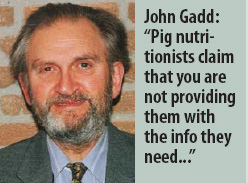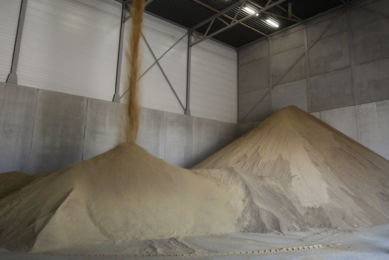What the textbooks don’t tell you about…Farm-specific diets (part one)

“What’s all this about?” you ask. “Surely the concept is well- known by now?” You know, and I know, that technical advances in the area of growing pig nutrition and genetic improvement have leapt ahead in the past few years. Talking to many commercial pig nutritionists and applied geneticists across the world has revealed some very frustrated people. At times this has slipped across into downright annoyance with you, the producer.
“John, start writing on farm-specific diets”, they say.
The pig nutritionists especially claim that you are not providing them with the information they need to use these advances in applied nutrition to the full. The nutritionist feels he is restricted in applying the new knowledge on feed ingredients and variable conditions on the farm (including genetic differences and marketing opportunities) by having insufficient information from the producer. This is a huge waste of new knowledge and research, costing up to 0.2 on Food Conversion (30-105 kg). They go on to add: “John, please start writing about Food Conversion yet again!”
Having said this, I believe the problem comes from producers not realising that the day of buying foods ‘off the shelf’ from a feed compounder’s brochure as of old are now gone and that the age of the ‘farm-specific’ diet (see below) is here to stay.
So this article sets the scene for two more articles providing a new look at that old favourite Food Conversion Ratio (FCR) and why commercial producers (but not academics and researchers) need to move on into pastures new.
The next piece examines the new thinking on Food Conversion, and the third one deals with what information you must provide to your feed supplier, the difference it makes, and why.
The farm-specific diet
Pig grow-out farms may look pretty similar but there are significant differences between them. The more important ones are market outlet demands, genetics, environment, management affecting feed intake especially, management influencing stress, immune demands and the effect of subclinical disease, local climate, stockmanship skills etc.Sure, the pig nutritionist may not need to be aware of them all, but information on certain ones is absolutely essential to enable him to use his skill and the new knowledge to the full. With this information he can also talk to the nutrition consultant advising the genetic supplier you prefer to use – because gene lines are different, not only between suppliers but also in-house as well. Just carry on using the gene lines you have chosen, but the nutritionist needs to know what they can do.I have an encouraging number of ‘before and after’ performance results from clients collected over the years. Of course I realise that ‘before and after’ evidence is subjective and prey to other influencing factors over the two to three years for significant differences to appear, and then register in the producers mind. Even so I feel that if you can collect a reasonable number of them then they are worth attention.Thus I show the box below which suggests that the nutritionists are only too right!
Note that in each case the same feed ingredients were available to the company nutritionist, but because he was provided with the information he deemed essential for each farm (in two cases for each building which were quite different) he was able to use them differently to good effect.
Convince yourself!
Please attend any lecture on how the modern pig nutritionist designs growing/ finishing feeds these days. Those given by Mick Hazzledine (Premier Nutrition), for example, will show you how complex it is and what information people like him need from you to dodge round things like ANF’s (anti-nutrient factors) and make better use of what raw material ingredients he is limited to use on grounds of cost and availability these days. From the geneticists viewpoint, listen to what Dr Grant Walling (JSR Genetics) is saying about how the correct gene mixes now and in future are going to influence FCR, among other things – especially in faster growing pigs to much heavier weights and identifying where the breakpoint may be. There are other good lecturers in both areas but these two are the tops for what you, the producer, need to know. Go and get updated. Remember – your farm is different and these vital nutrition specialists need your information to save you costs and increase your income through improved performance.
Farm-specific diets Examination of quarterly performance records for 15 growing/finishing farms on changing from a feed compounder’s price-list feeds to farm-specific diets, in most cases designed by the same compounder’s nutritionist. (The results are not necessarily all additive in most cases) • Pigs ranged from 28-35 kg to 101-105 kg liveweight • Food conversion better by 0.18:1* • MTF improved by 12 kg/tonne** (Range 5-21 kg) • ADG rose by 23 g/day* • Cost/kg/gain fell by €0.02 • Feed cost/tonne rose by 4.6%* (Range 2-9%) • Medication costs fell by 4% (Range 0-9%) Note: * Averages of all 15 units; ** Averages of 11 units Comment: Due to the input needed by the company’s formulation dept(s), feed cost rose by 4.6% (range 2 to 9%) and not all of the average benefits listed above were secured by everyone, but in every case – as far as I could see – extra gross margin comfortably exceeded the higher feed cost per tonne. |











